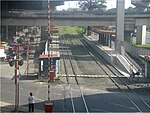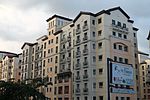NAIA Expressway
Infobox road instances in the PhilippinesInfobox road temporary tracking category 1Roads in Metro ManilaToll roads in the PhilippinesUse Philippine English from May 2023 ... and 1 more
Use mdy dates from June 2020

The Ninoy Aquino International Airport Expressway (NAIAX), signed as E6 of the Philippine expressway network, is an 11.6-kilometer (7.2 mi) elevated expressway in Metro Manila, Philippines, which links the Skyway to Ninoy Aquino International Airport and Entertainment City. Traversing the cities of Pasay and Parañaque, the NAIAX runs along Andrews Avenue, Electrical Road, and NAIA Road connecting the Skyway to Ninoy Aquino Avenue, Macapagal Boulevard, New Seaside Drive and the Manila–Cavite Expressway.The expressway is the first airport expressway in the Philippines. It opened in September 2016. It traverses the cities of Pasay and Parañaque.
Excerpt from the Wikipedia article NAIA Expressway (License: CC BY-SA 3.0, Authors, Images).NAIA Expressway
8th Street, Pasay Zone 20 (District 1)
Geographical coordinates (GPS) Address Nearby Places Show on map
Geographical coordinates (GPS)
| Latitude | Longitude |
|---|---|
| N 14.520833333333 ° | E 121.0225 ° |
Address
Villamor Air Base Golf Course
8th Street
1232 Pasay, Zone 20 (District 1)
Philippines
Open on Google Maps








